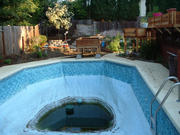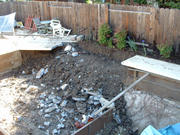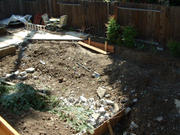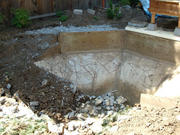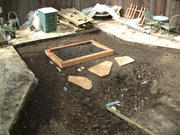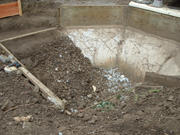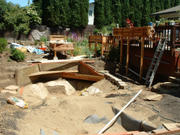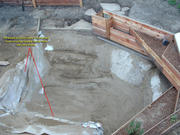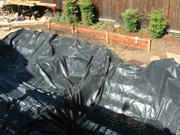



As easy as 1-2-3!
SIMPLE DO-IT YOURSELF(DIY) SWIMMING POOL REMOVAL
This method of pool removal is so simple it amazed me. Don't get me wrong, it is the method that is easy, the work itself involves some muscle. Imagine how much dirt it would take to fill a medium sized swimming pool. Now imagine if the soil level were dropped by 2 feet. Now imagine a pond somewhere where the pool used to be. Given these senarios, how much dirt would it take to fill that swimming pool now? The answer is much less... much, much less.
How much extra fill-dirt will be needed from an outside source? The answer is "None!"
No tractors ruining your yard. No contractors to charge you anything. As long as your yard is a little larger than your pool, you are in business. I don't know why people haven't thought of this sooner.
For step-by-step instructions go
HERE.
Let's use the yard and
pool from my previous post where I calculated its volume to be about 1600 cubic feet.
Now let us take the soil line down 2 feet around the pool. We will give it a little shape and give it a little slope on one end back up to the original line.

I left the pool in to show where it was in reference to the new soil line. The top of the pool that is above that new ground line can now have its volume subtracted from the volume of fill dirt needed. Using the exact same method I used in the previous post I can find the volume of the removed portion of the pool using 2 feet as the depth. It comes out to be 610 cubic feet. Subtract that from the total volume to get your
adjusted volume, and you are just left with approximately 900 to 1000 cubic feet that will need to be filled in. If you add a pond, you can make that total even lower.
If you want to calculate the area around your pond that will have to be removed in order to fill your hole you will first need to know how much fill dirt will be required. That is why I have been going on about pool volume. Once you have that number you will need to use the following formula:
Width x Height x D =
Total Pool Volume
Where "D" represents the amount of the dirt line to be removed. 2 feet seems to work out great for most pools.
You must use the total pool volume, not the adjusted volume. In other words, do not subtract the portion of the pool that would be above the new dirt line. While you don't need to fill that portion of the pool anymore, you also do not have any dirt in that portion already. So they offset each other. Let's use the example that I calculated in the previous post where the total volume was 1600 cubic feet. You will use the total volume(1600) without subtracting the 610 as I just stated above. You never use the
adjusted volume(900 to 1000).
- W x H x 2 = 1600
- W x H = 1600 / 2
- W x H = 800
So now you have to plug in some numbers that will work for your yard.
For the above yard I could use the following:
- 20 x 40 = 800
- 25 x 32 = 800
- 16 x 50 = 800
- etc...
So I will need to remove an area around my pool approximately 20'x40' or 25'x32' or 16'x50' or some other numbers that equal 800. The above example is for a total fill in, if you are adding a pond you need to subtract the pond volume from the 800 and go from there.
With my actual yard, I had a few obstacles that prevented me from an easy calculation, so I just went ahead with the knowledge I would fill it completely at some point, and that is where I would stop. It didn't take much dirt at all. I had a concrete deck around my pool, so I used the concrete to start the fill in.
If you can see the whole picture correctly you will notice that the dirt you removed from around the pool went directly in the hole to fill it up. While you do this you build a frame for your pond once you have the bottom filled up to a proper height to allow a pond. In some cases you will need to build the frame before you start filling because you want your pond as deep as possible so you won't want to fill any of the bottom of the pool. Basically the pool bottom will now be your pond bottom. In either case, place your new pond frame and keep filling around it with the dirt you are removing from around the pool. Sooner or later you will reach a point were either you have completely filled the pool and your pond is perfectly in place, or you have reached the limit of dirt that you want to remove from your yard. In the latter case you will just need adjust the pond size accordingly(make it larger). If you are not putting in a pond then once it is filled, you are pretty much done. Just landscape and enjoy your new yard without a pool!
If you put in a pond, then celebrate in knowing that the most difficult, and by difficult I mean "backbreaking", part of the project is over.


Here is a lot of photos from my project where I filled in my pool using this method. I used the concrete from the pool decking to fill in the pool initially. Since I did not know exactly how much dirt I was going to have under the decking, I put up a temporary retaining wall to keep the dirt and concrete from filling up too much of the hole. Once I saw that I had plenty of dirt I started building the permanent pond frame and just filled up around it. I also used some re-bar drilled 3 feet into the ground to give the ground some stability from the loose concrete blocks.
